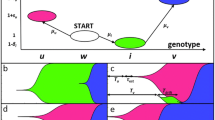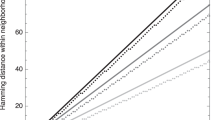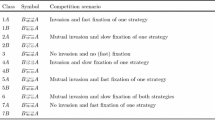Abstract
We analytically study the dynamics of evolving populations that exhibit metastability on the level of phenotype or fitness. In constant selective environments, such metastable behavior is caused by two qualitatively different mechanisms. On the one hand, populations may become pinned at a local fitness optimum, being separated from higher-fitness genotypes by a fitness barrier of low-fitness genotypes. On the other hand, the population may only be metastable on the level of phenotype or fitness while, at the same time, diffusing over neutral networks of selectively neutral genotypes. Metastability occurs in this case because the population is separated from higher-fitness genotypes by an entropy barrier: the population must explore large portions of these neutral networks before it discovers a rare connection to fitter phenotypes.
We derive analytical expressions for the barrier crossing times in both the fitness barrier and entropy barrier regime. In contrast with ‘landscape’ evolutionary models, we show that the waiting times to reach higher fitness depend strongly on the width of a fitness barrier and much less on its height. The analysis further shows that crossing entropy barriers is faster by orders of magnitude than fitness barrier crossing. Thus, when populations are trapped in a metastable phenotypic state, they are most likely to escape by crossing an entropy barrier, along a neutral path in genotype space. If no such escape route along a neutral path exists, a population is most likely to cross a fitness barrier where the barrier is narrowest, rather than where the barrier is shallowest.
Similar content being viewed by others
References
Adami, C. (1995). Self-organized criticality in living systems. Phys. Lett. A. 203, 29–32.
Barnett, L. (1998). Ruggedness and neutrality: the NKp family of fitness landscapes, in ALIFE VI, Available at: http://www.cogs.susx.ac.uk/users/lionelb/.
Bergman, A. and M. W. Feldman (1996). Question marks about the period of punctuation. Technical Report, Santa Fe Institute Working paper 96-02-006.
Christiansen, F. B., S. P. Otto, A. Bergman and M. W. Feldman (1998). Waiting with and without recombination: The time to production of a double mutant. Theor. Pop. Biol. 53, 199–215.
Crutchfield, J. P. and M. Mitchell (1995). The evolution of emergent computation. Proc. Natl. Acad. Sci. USA 92, 10742–10746.
Crutchfield, J. P. and E. van Nimwegen (2000). The evolutionary unfolding of complexity, in Evolution as Computation, Lecture Notes in Computer Science, L. F. Landweber, E. Winfree, R. Lipton and S. Freeland (Eds), New York: Springer-Verlag, Santa Fe Institute Working Paper 99-02-015; adap-org/9903001.
Derrida, B. and L. Peliti (1991). Evolution in a flat fitness landscape. Bull. Math. Biol. 53, 355–382.
Eigen, M. (1971). Self-organization of matter and the evolution of biological macromolecules. Naturwissen. 58, 465–523.
Eigen, M., J. McCaskill and P. Schuster (1989). The molecular quasispecies. Adv. Chem. Phys. 75, 149–263.
Elena, S. F., V. S. Cooper and R. E. Lenski (1996). Punctuated evolution caused by selection of rare beneficial mutations. Science 272, 1802–1804.
Ewens, W. J. (1979). Mathematical Population Genetics, volume 9 of Biomathematics, New York: Springer-Verlag.
Fontana, W. and P. Schuster (1998). Continuity in evolution: On the nature of transitions. Science 280, 1451–1455.
Frauenfelder, H. (Ed.) (1997). Landscape Paradigms in Physics and Biology. Concepts, Structures and Dynamics (Papers originating from the 16th Annual International Conference of the Center for Nonlinear Studies. Los Alamos, NM, USA, 13–17 May 1996), Amsterdam: Elsevier Science, Published as a special issue of Physica D 107, 2–4 (1997).
Gardiner, C. W. (1985). Handbook of Stochastic Methods, New York: Springer-Verlag.
Gavrilets, S. (1997). Evolution and speciation on holey adaptive landscapes. Trends Ecol. Evol. 12, 307–312.
Gavrilets, S. (1999). A dynamical theory of speciation on holey adaptive landscapes. Am. Naturalist 154, 1–22.
Gavrilets, S. and J. Gravner (1997). Percolation on the fitness hypercube and the evolution of reproductive isolation. J. Theor. Biol. 184, 51–64.
Gould, S. J. and N. Eldredge (1977). Punctuated equilibria: The tempo and mode of evolution reconsidered. Paleobiology 3, 115–251.
Harris, T. E. (1989). The Theory of Branching Processes, New York: Dover publications.
Huynen, M., P. F. Stadler and W. Fontana (1996). Smoothness within ruggedness: The role of neutrality in adaptation. Proc. Natl. Acad. Sci. USA 93, 397–401.
Kauffman, S. A. and S. Levin (1987). Towards a general theory of adaptive walks in rugged fitness landscapes. J. Theo. Bio. 128, 11–45.
Kimura, M. (1962). On the probability of fixation of mutant genes in a population. Genetics 47, 713–719.
Kimura, M. (1964). Diffusion models in population genetics. J. Appl. Prob. 1, 177–232.
Kimura, M. (1983). The Neutral Theory of Molecular Evolution, Cambridge University Press.
Lande, R. (1985). Expected time for random genetic drift of a population between stable phenotype states. Proc. Natl. Acad. Sci. USA 82, 7641–7645.
Macken, C. A. and A. S. Perelson (1989). Protein evolution in rugged fitness landscapes. Proc. Natl. Acad. Sci. USA 86, 6191–6195.
Maynard Smith, J. (1970). Natural selection and the concept of a protein space. Nature 225, 563–564.
Newman, C. M., J. E. Cohen and C. Kipnis (1985). Neo-darwinian evolution implies punctuated equilibrium. Nature 315, 400–401.
Newman, M and R. Engelhardt (1998). Effect of neutral selection on the evolution of molecular species. Proc. R. Soc. Lond. B. 256, 1333–1338.
Nowak, M. and P. Schuster (1989). Error thresholds of replication in finite populations, mutation frequencies and the onset of Muller’s ratchet. J. Theor. Biol. 137, 375–395.
Prügel-Bennett, A. and J. L. Shapiro (1994). Analysis of genetic algorithms using statistical mechanics. Phys. Rev. Lett. 72, 1305–1309.
Reidys, C. M., P. F. Stadler and P. Schuster (1997). Generic properties of combinatory maps—Neutral networks of RNA secondary structures. Bull. Math. Biol. 59, 339–397.
van Kampen, N. G. (1992). Stochastic Processes in Physics and Chemistry, Amsterdam: North-Holland.
van Nimwegen, E. (1999). The statistical dynamics of epochal evolution, PhD thesis, University of Utrecht, Available electronically at: http://www.santafe.edu/projects/evca/ErikVanNimwegen.html.
van Nimwegen, E. and J. P. Crutchfield (2000a). Optimizing epochal evolutionary search: Population-size dependent theory, in Machine Learning, Santa Fe Institute Working Paper 98-10-090. adap-org/9810004, in press.
van Nimwegen, E. and J. P. Crutchfield (2000b). Optimizing epochal evolutionary search: Population-size independent theory, in the Special Issue on Evolutionary and Genetic Algorithms in Computational Mechanics and Engineering, D. Goldberg and K. Deb (Eds), Comput. Meth. Appl. Mech. Engng. 186, 171–194.
van Nimwegen, E., J. P. Crutchfield and M. Mitchell (1997). Finite populations induce metastability in evolutionary search. Phys. Lett. A 229, 144–150.
van Nimwegen, E., J. P. Crutchfield and M. Mitchell (1999). Statistical dynamics of the Royal Road genetic algorithm, in the Special Issue on Evolutionary Computation, A. Eiben and G. Rudolph (Eds), Theoret. Comput. Sci. 229, 41–102
Weisbuch, G. (1991). Complex Systems Dynamics: An Introduction to Automata Networks, volume 2 of Santa Fe Institute Studies in the Sciences of Complexity, Lecture Notes, Reading, MA: Addison-Wesley.
Wright, S. (1932). The roles of mutation, inbreeding, crossbreeding and selection in evolution, in Proceedings of the Sixth International Congress of Genetics, Vol. 1, pp. 356–366.
Wright, S. (1982). Character change, speciation, and the higher taxa. Evolution 36, 427–443.
Author information
Authors and Affiliations
Corresponding authors
Rights and permissions
About this article
Cite this article
van Nimwegen, E., Crutchfield, J.P. Metastable evolutionary dynamics: Crossing fitness barriers or escaping via neutral paths?. Bull. Math. Biol. 62, 799–848 (2000). https://doi.org/10.1006/bulm.2000.0180
Received:
Accepted:
Issue Date:
DOI: https://doi.org/10.1006/bulm.2000.0180




